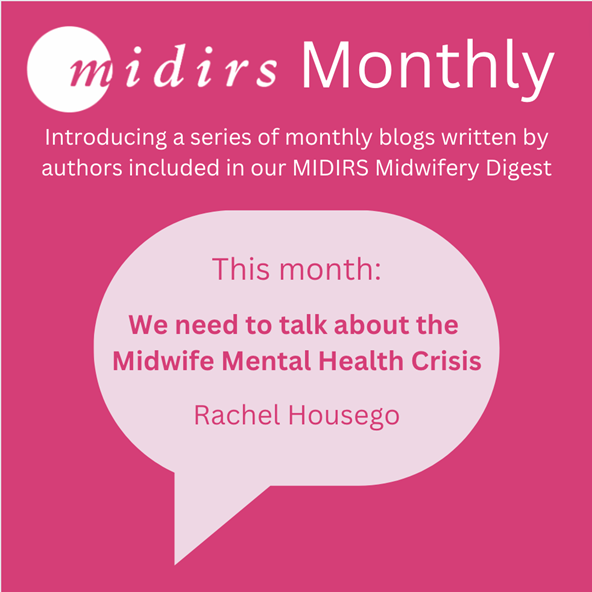MIDIRS Monthly - We need to talk about the Midwife Mental Health Crisis
By Rachel Housego on 28 April 2023
An Informal Introduction
I am sitting here in a coffee shop, thinking about the profession, and the journey I began as a teenager, and it is with this hindsight (and a very large coffee) that I consider the ways in which midwifery has made me who I am today. My experience within the profession has not always been sunshine and roses, but on the whole, it has been an adventure (excuse the cliché) which I have enjoyed; I would be a completely different person, had I not taken the steps to becoming a midwife in September 2015, and I am happy with the path I have chosen.
I like the Rachel who has grown confidence in speaking to people from all walks of life, who can confidently care for families and who has driven home from shifts on a post-delivery high. I even like the person who has been burnt out and sad, but who knows they have done their best for a family suffering a bereavement. This career has taught me an array of things, which I could discuss, but I want to focus on is something that is extremely pertinent during the NHS staffing crisis – midwife mental health.
The Facts: Prevalence of Mental Health Conditions
Most people, regardless of profession, experience a mental health problem during their lifetime; 1 in 6 people have been reported to experience symptoms of a mental health condition over the course of a week (McManus et al., 2016). This figure is likely to be even higher considering it does not consider the increased prevalence of mental health conditions associated with the COVID-19 pandemic (Office for National Statistics (ONS), 2021) and the current cost of living crisis (ONS, 2022). Although, these figures are not specific to midwives, it is prudent to consider that midwives fall within this population and also work in an environment which faces stress, trauma, bereavement, and service shortages.
To highlight the midwife mental health crisis in statistical terms, the UK WHELM study surveyed 1,997 midwives, representing 16% of those registered with the RCM (Royal College of Midwives) (Hunter, 2017). They found 83% of participants suffered from burnout, 67% of which was workload related (Hunter, 2017). In addition to this, 36.7% of midwives reported moderate/severe/extreme levels of stress, anxiety, and depression (Hunter, 2017).
The NHS (2022) Staff Survey also found that 39.7% of nurses and midwives experience burnout, with previous reports highlighting that perceived stress was highest among midwives (51.6%) (NHS, 2018). Furthermore, Nightingale et al. (2018) found 5% of midwives to have scores commensurate with a clinical diagnosis of post-traumatic stress. These figures alone indicate a significant mental health crisis within the midwifery profession.
It would be remiss not to consider the positive influence maternity care can have on mental health – I can attest to the joy I have experienced in my career. Nonetheless, this does not mitigate the negative implications maternity service structure, staffing, and the role itself, can have on mental health. Cull et al. (2020) found high satisfaction among midwives who take pleasure in their work, seeing it as a source of pride and self-esteem. These positive emotions may somewhat negate the challenges faced by maternity staff, but the current conditions are likely to erode engagement and increase attrition over time (Cull et al., 2020)
The Factors Affecting Mental Health
The midwifery profession has changed drastically. Even since I began my training, and I am a ‘fetus’ in terms of my career (I like to think), there has been a noticeable change within the profession. One significant change is the increasing medical involvement – a concept known as medicalisation (Davison, 2020). This is demonstrated in data, showing increasing rates of epidurals and caesareans, and decreasing rates of physiological birth (CQC, 2022). This is not entirely negative though; maternal (Donaldson and Rutter, 2018) and fetal (NHS England, 2019) mortality has decreased significantly due to medical intervention – the importance of which I am not disputing.
Yet, despite intrapartum guidelines (WHO, 2018; NICE, 2017) advising a physiological approach to birth, where clinical intervention is used when indicated (Miller et al., 2016; WHO, 2018), sources suggest midwifery-led care has become harder to practice (Hadjigeorgio and Coxon, 2014; Hopkins 2000) and that intervention is overused (Dahlen et al., 2022) and unjustified (McDougall et al., 2016). A concerning finding when considering birth trauma is more prevalent in women following intervention (Dahlen et al., 2022).
Why am I talking about medicalisation when we are focused on midwife mental health? Well, research indicates that midwives who practice against their beliefs are more likely to suffer mentally (Hunter, 2004; Hunter and Sergott, 2008). My recent study (Housego, 2023) suggested midwives who work on midwifery-led units, and felt they practiced true midwifery-led care, did not disclose as many experiences of burnout or poor mental health, when compared with midwives who worked predominately in an obstetric-led setting. This might not be entirely causal, or apply to all midwives, but resonates with literature which has identified that midwives experience emotional difficulty when they cannot practice according to their philosophies and beliefs (Hunter, 2004). After all, does anyone apply to be a midwife with the aim of not providing ‘with woman’ midwifery care?
Perhaps then, we need to tackle medicalisation of birth and consider shifting measured outcomes beyond mortality (Shaw et al., 2016), focusing on factors such as maternal satisfaction. Yet, in a risk averse culture and a society, which due to epidemiological transition, faces a higher prevalence of chronic conditions (McDougall, 2016) - is it possible, or appropriate, for this shift in focus?
After all, a culture of blame is rife within maternity (Lintern, 2022). Dahlen et al. (2022) state midwives are blamed in the event of a poor outcome, creating a risk-averse culture which does not centre on women’s needs. Einion (2017) reiterates this and states that risk management permeates every aspect of society; we limit risk in our daily lives, and death or illness is to be avoided at all costs, why should the childbirth continuum be any different? In fact, successful risk assessment and management, has helped reduce maternal and neonatal morbidity and mortality (Shaw et al., 2016).
Conversely, a risk averse culture can induce a fear of childbirth; where there is a potential poor outcome, there is a potential for fear. In my study (Housego, 2023), midwives reported a fear of childbirth within the profession, which is exacerbated by a lack of physiological experience and the blame culture (Lintern, 2022). The notion of fear is highlighted in other literature (Kirkham, 1999; Essex et al., 2013), and midwives have reported that birth unpredictability results in fear and leads them to be cautious and zealous in their care (Page and Mander, 2014). A risk orientated service is perhaps one means of addressing poor mental health, although the long-standing implications of this to maternal and neonatal outcomes are questionable – does it lead to overused (Dahlen et al., 2022) and unjustified (McDougall et al., 2016) intervention?
In addition, midwifery, as beautiful as it can be, can also be emotionally draining and have a demoralising effect on midwives (Hunter, 2004; Hunter and Segrott, 2008; Housego, 2023). Providing consistent emotional support to a family, can take a toll on the care provider, particularly when considering the long shifts. There is also evidence to suggest that a traumatic birth can affect the midwife as much as the mother (Patterson, 2019), which is of no surprise when considering we are experts in forging alliances with women. Yet, a midwife who faced a traumatic experience and developed PTSD (Housego, 2023), stated that there was no support. This is even more pertinent considering mental health has reportedly been exacerbated by the pandemic (RCM, 2020).
These mental health stressors are but a few which culminate to exacerbate the staffing crisis. The RCM (2021) survey found midwives were planning to leave the profession due to staffing and the poor quality of care midwives were able to provide. Midwives have also commented on how they feel defeated after strenuous shifts that were exacerbated by staffing shortages (Housego, 2023). This is evidenced in the estimated shortfall of 3,500 midwives in 2018 (RCM, 2018) and the latest Ockenden report (Ockenden, 2022).
A summary
Midwifery can be rewarding and beautiful, but it can be traumatic and stressful. Fundamentally, wonderful, and passionate, midwives are leaving the profession due to lack of staff, burnout, post-traumatic stress disorder, and depression. When providing the deeply compassionate, ‘with woman’ care we aspire to, it can take an emotional toll – something that is often overlooked. In addition, midwives are unwittingly, or regretfully medicalising care to alleviate some of the burden they are under (Housego, 2023). Therefore, not only does the mental health of midwives affect them, their families, and their life course, but it also affects the care provided to families.
Many midwives I know love their job; it is a calling, a vocation, or a life-long dream. Yet, one comment frequently made is: “I love midwifery, hate the politics”. The ‘politics’ relating to staffing pressures, pay, and general working conditions. This possibly also relates to the workplace cultures, and sometimes even bullying cultures, that can permeate maternity care. Regardless, I want to point out here, that midwives keep turning up. Despite the politics, the burnout and the stress, people show up and deliver excellent care to women.


